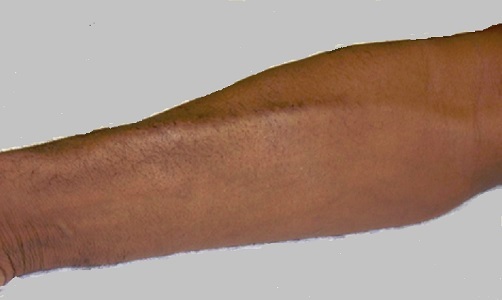Blog Post by Dialysis Access Center
Posted on Aug 20, 2013 at 10:00 PM

Taking Care of Your Dialysis Access
To get hemodialysis we need a way to repeatedly reach your blood so it can go to the artificial kidney (dialyzer) to be cleaned. For this one needs a dialysis vascular access. There are three kinds of access: fistulas, grafts and catheters. A fistula is blood vessel that is formed by linking an artery and a vein under your skin in your arm (or leg). Arteries have fast blood flow. Veins are close to the skin and easy to reach with dialysis needles. Linking them together makes a large vessel with fast flows that can be used for dialysis. A graft is a piece of tubing that is used to connect your own artery and vein under your skin. It can be stuck with needles for dialysis. A catheter is a double lumen tube. For hemodialysis, it is placed into a central vein in the neck or groin. Catheters and Grafts are more likely to get infected than fistulas as they are artificial. If feasible, arteriovenous (AV) fistulas are the best choice. AV fistulas can last for years and tend to have the fewest problems.
You have a limited number of places on your arms and legs where a doctor can create an AV fistula. Take steps to protect those places so you can use them in the future. Avoid blood draws and IV’s especially in your non-dominant arm. The best place to draw blood is on the back of your hands.
You’re not alone if you worry about needles. It may help you to know that you can use a numbing medicine, cream or cooling spray before each treatment, so when needles are placed it won’t hurt. In most dialysis centers, a skilled nurse will be the first one to try out your new AV fistula.
Even the best staff person can have a bad day and miss cannulating your fistula or graft. A needle can go through your fistula wall and out the other side so blood leaks into your tissues under the skin. This is called infiltration, and it can cause a bruise. If this happens apply ice to decrease the amount of swelling and notify your dialysis access care team. The location where the needles are placed at each dialysis is also the key for your long-term fistula health. Learning to put in your own needles gives you control. It’s easy to learn and do, and just about pain free.
The dialysis center staff will check your fistula before, during, and after each treatment. There are many monitoring techniques used at dialysis including dialysis adequacy, flow measurements, venous pressure monitoring and Vasc-Alert which is a ratio of access pressure and your average blood pressure. If there are any warning signs or symptoms during the monitoring then you may be referred to an access center for further evaluation by a dialysis access doctor.
A healthy vascular access is very important to having ongoing successful dialysis treatments. There is a ‘One Minute Access Check’ you can do every day to find any potential problems and get the help you need from your access care team as it could save your lifeline from unwanted complications. There are three steps in the ‘One Minute Access Check’: Look, Listen and Feel.
1. Look at the skin over you access and make sure it’s one color and similar to the skin around it. If there is any redness, swelling, or drainage, or if the is any skin bulges with shiny , bleeding or peeling skin, contact your dialysis access care team immediately. Video on Look
2. Listen to your access by placing it close to your ear. It should sound like the same as the last time you listened to it when it was functioning well. If it sounds different or you hear no sounds, then report it to your dialysis access care team. Video on Listen
3. Feel for a thrill and a pulse. Thrill is a vibration or buzz along the whole length of the fistula. It is best felt by the ball of your hand or your fingertips. Pulse is alight beating like a heart beat. Fingers placed lightly on an access should move slightly. When the pulse beat is stronger than usual and it rises and falls with each beat or if there is no thrill, contact your dialysis access care team. Video on Feel
You can learn and should know what the dialysis care team members are doing and play an active role in your own care. It’s your dialysis lifeline. Take charge!
Leave a Comment:
Blog Search
Blog Categories
Dialysis Access Center
Make an appointement today to take care of your access. Call us at (510) 251-1002.